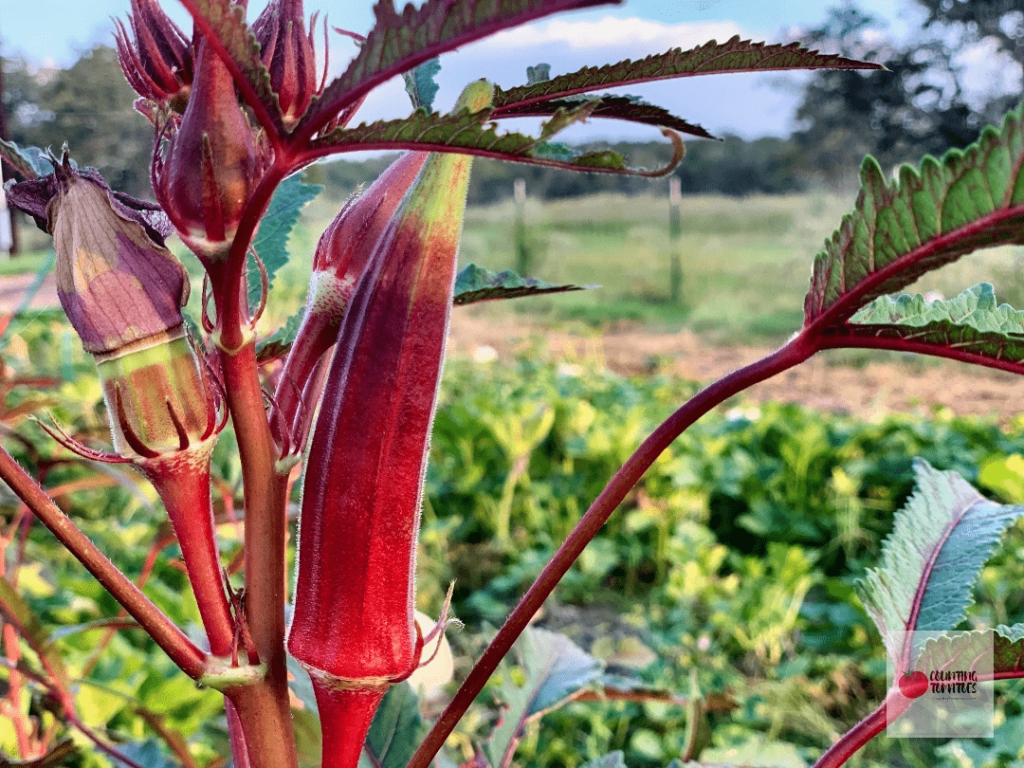
In this blog post, we will guide you through the process of how to grow okra in Texas and provide you with tips and tricks to ensure a successful harvest. Okra (abelmoschus esculentus) is native to west Africa and was first introduced to the Southern United States with the slave trade. Okra has been a staple of southern cuisine! Okra can be served raw, fried, pickled, roasted and in gumbo. Also known as lady’s fingers, it is a warm-season vegetable that thrives in the hot and humid climate of Texas. Not only is okra a delicious addition to many dishes, but it is also a relatively easy plant to grow in your own backyard.
Table of Contents
When to Plant Okra in Texas
Okra plants do not tolerate frost or even cool days or nights. As a general rule of thumb, in the southern half of Texas plant okra the first two weeks of April and in the northern half of the state, plant okra during the last two weeks of April.
The optimal soil temperatures for okra germination are 75°F – 90°F.
If you want to get a head start on okra before the soil is warm outdoors, you can start the seeds in seed starting trays on a heat mat. Be sure to harden off the seedlings before moving them outdoors permantely. The okra seedlings can be transplanted into the garden or into a container outdoors when ready.
Where to Plant Okra
Okra is not high maintenance and will thrive in the hot summers of Texas as well as other southern states. The biggest key to growing okra is to plant it in well-drained soil rich in organic matter.
Okra thrives in full sun and will not grow well with less than 8 hours of direct sunlight daily.
I grow okra in rows in the in ground garden, but I have also grown it in raised beds. Okra requires deep roots to tolerate the heat and drought in mid-summer. If planting okra in raised beds, ensure the beds are at least 12” deep to accommodate the root system.
How to Plant Okra Seeds
Dig a furrow 1/2” deep and plant okra seeds in a straight row spaced 12” – 18” apart. If planting multiple rows of okra, row spacing of 36” is preferred.
For best results, sprinkle a granular all-purpose fertilizer in the planting furrow according to the package directs before sowing your seeds. This is a good choice of fertilizer; you’ll use 1.5 cups for every 10’ of row planted.
I use the Hoss Walk Behind Seeder to plant okra. The seeder digs the furrow, sows the okra seeds and covers the seeds in one pass. It’s a quick way to get the garden planted!
As plants mature, you will notice production declines. Okra can be succession planted in the spring, summer and fall to ensure you have an abundant harvest throughout the growing season.
The Best Okra Varieties to Grow
From heirloom varieties to hybrids, there’s an okra variety you’re sure to love growing.
Clemson Spineless – The Clemson Spineless okra variety is one of the most popular varieties and is the variety I plant year after year. This variety was an All American Selections winner in the 1930’s and has been grown for decades by gardeners. The plants each a mature height of approximately 4 feet tall and have fewer spines. Harvest the pods when they are 3” – 4” in length. The pods become woody and tough when grown larger but are excellent for ornamental decoration.
Jing Orange – If you are looking for a unique okra choose this reddish orange pod variety. A definite beauty while growing; the pods turn green when cooked. Jing Orange okra is best picked when the pods are 3” – 4” long but will remain tender up to 6” long. Excellent in stir-fry!
Jambalaya Okra – If you want to have early producing and productive okra, the Jambalaya Okra variety is the one to choose. This plant will start producing pods when it is only 1 – 2’ tall. The plants will mature at 5’ – 6’ tall and are heavy yielding. Pick these pods when their 4” – 6” long to fry, stew or pickle. Jambalaya okra is very productive, so if you do not want to harvest okra every one to two days, this may not be the best choice for your garden.
Cowhorn Okra – Gardeners have been growing the Cowhorn Okra variety since the early 1900’s. The green pods are long and slender and should be picked when they are 6” – 10” in length.
Can you Grow Okra in Containers?
Absolutely, okra can be grown in a container when you choose the right variety. The best okra variety to grow in a container is the Green Fingers Okra variety. The plants are compact and only reach about 15” in height. Planting 8 plants in containers will feed 2 people throughout the season. Green Fingers Okra is self-pollinating and idea for a patio or balcony garden.
How to Water Okra Plants
Okra will grow in dry conditions, but you will get the best yields when you water the plants every 7 to 10 days. Okra will need 1 inch of water per week or up to 2 inches during peak temperatures. Sandy soils will require more frequent watering. Water at the base of the plant. If planting in the ground, drip irrigation is the best way to water to avoid getting water on the leaves.
Excess moisture on the plant leaves can encourage bacterial disease. If watering container planted okra, use a watering wand to water at the base of the plant.
How to Fertilize Okra
The granular fertilizer in the planting furrow will offer a good start after the seeds germinate.
Fertilize your okra plants about a month after planting with a balanced fertilizer or compost. Avoid excessive nitrogen fertilizers as too much nitrogen will result in more foliage growth at the expense of fruit production.
Okra Pests and Diseases
Like any garden plant, okra can be plagued by pests and disease. Fusarium wilt, bacterial wilt, southern blight and powdery mildew are diseases that can plague okra. Crop rotation, pest control and watering at the base of the plant is your biggest defense against these diseases.
Root knot nematode are also a problem with okra plants as well as other plants in the nightshade family. Be sure to practice crop rotation and do not plant okra where a previous member of the nightshade family, such a tomatoes, peppers or eggplant were growing the previous couple of seasons. If crop rotation is not possible, you can use methods of soil sterilization and neem oil meal fertilizer to reduce the population of root knot nematodes.
If you must treat disease a good organic product is Monterey Complete Disease Control for powdery milk, gray mold and leaf spots. Be sure to dispose of any diseased plants and do not compost them.
Common pests on okra are aphids, thrips, stinkbugs, hornworms, armyworms, spider mites, white flies and fire ants. Organic pests control choices are insecticidal soap, Neem oil, diatomaceous earth, Monterey Take Down Spray and Bug Buster O. Follow the manufacturers label for directions. A non-organic insecticide is Monterey Bug Buster II, but it’s always best to use the organic choice first.
Can you Prune Okra?
Okra plants also benefit from regular pruning. Prune the lower leaves of the plant to improve air circulation and reduce the risk of fungal diseases. Harvesting the okra pods regularly also encourages the plant to produce more.
When to Harvest Okra
Okra should be harvested when the pods are tender and not hard and fibrous. Okra varieties can vary widely when pods reach the optimal size. Cowhorn okra pods can grow up to 10” long and still be tender. Green Fingers okra is best harvested when the pods are 2 – 3” long. The back of each seed packet will be your guide to the maturity size on each variety.

How to Harvest Okra
Okra is very tough to pull from the plant. Use a sharp knife or pruning sheers to remove each pods from the plant. Leave 1/8” to ¼” long stem on each pod to avoid cutting the main stem of the okra plant. Okra spines can cause skin irritation and discomfort; it’s best to wear long sleeves or wear gloves when harvesting.
Regularly harvest your okra to encourage the continuous production of new pods.
The beautiful flowers are also an edible part of the okra plant. These can be battered and fried for a tasty treat in addition to the green pods.
How to Store and Prepare Okra
Store okra unwashed in the refrigerator for up to 3 days in a ventilated bag. You can use a mesh bags or poke several holes a plastic bags. Okra can be blanched and then frozen in freezer bags for longer term storage. Many people enjoy pickled okra in the south as well.
Conclusion
Growing okra in Texas can be a rewarding experience for home gardeners. By choosing the right variety, providing adequate sunlight, water, and nutrients, and taking care of maintenance tasks, you can enjoy a bountiful harvest of this versatile vegetable. Remember to experiment with different cooking methods and recipes to fully appreciate the unique flavor and texture of freshly grown okra. Happy gardening!


